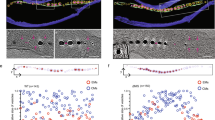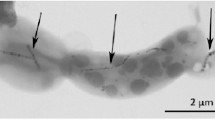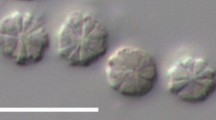Abstract
We have studied the disposition of chains of magnetosomes inside magnetotactic cocci with light and electron microscopy. Light microscopy of isolated cocci indicated that the chains of magnetosomes are disposed on opposite sides of the cell. Electron spectroscopic imaging of whole unprocessed bacteria, showed the magnetosome chains in the cells. Freeze-etching of the cell surface allowed the observation of the close association of the chain with the cell surface. During the replication process of the freeze-etching, the magnetosome chains remained attached to the replicas, which indicates that chains were very close to the cell surface before freezing. We provide evidence that the large area of the contact faces between magnetosomes in a chain may provide an extra mechanical stability that helps keep the magnetosomes in chains even after isolation from the bacteria. Comparison with pointed magnetosomes from different cocci present in the same samples showed that the maintenance of linear chains is more difficult to be achieved because of the geometry of the crystals.
Similar content being viewed by others
References
Devouard B., Posfai M., Hua X., Bazylinski D.A, Frankel R.B. and Buseck P.R. 1998. Magnetite from magnetotactic bacteria: Size distributions and twinning. Am. Mineral. 83: 1387–1398.
Farina M., Kachar B., Lins U., Broderick R. and Lins de Barros H.G. 1994. The observation of large magnetite (Fe3O4) crystals from magnetotactic bacteria by electron and atomic force microscopy. J. Microsc. 173: 1–8.
Frankel R.B. 1984. Magnetic guidance of organisms. Annu. Rev. Biophys. Bioeng. 13: 85–103.
Frankel R.B., Bazylinski D.A., Johnson M.S. and Taylor B.L. 1997. Magneto-aerotaxis in marine coccoid bacteria. Biophys. J. 73: 994–1000.
Frankel R.B., Bazylinski D.A. and Schuler D. 1998. Biomineralization of magnetic iron minerals in bacteria. Supramol. Sci. 5: 383–390.
Freitas F., Keim C.N., Kachar B., Farina M. and Lins U. 2003. Envelope ultrastructure of uncultured naturally occurring magneto-tactic cocci. FEMS Microbiol. Lett. 219: 33–38.
Guerin W.F. and Blakemore R.P. 1992. Redox cycling of iron sup-ports growth and magnetite synthesis by Aquaspirillum magne-totacticum. Appl. Environ. Microbiol. 58: 1102–1109.
Gorby Y.A., Beveridge T.J. and Blakemore R.P. 1988. Characterization of the bacterial magnetosome membrane. J. Bacteriol. 170: 834–841.
Hanzlik M., Winklhofer M. and Petersen N. 1996. Spatial arrangement of chains of magnetosomes in magnetotactic bacteria. Earth Planet. Sci. Lett. 145: 125–134.
Hanzlik M., Winklhofer M. and Petersen N. 2002. Pulsed-field-remanence measurements on individual magnetotactic bacteria. J. Magn. Magn. Mat. 248: 258–267.
Lins U. and Farina M. 1999. Phosphorous-rich granules in uncultured magnetotactic bacteria. FEMS Microbiol. Lett. 172: 23–28.
Lins U., Farina M. and Lins de Barros H.G. 1992. Contribution of electron spectroscopic imaging to the observation magnetic bac-teria magnetosomes. Microsc. Eletr. Biol. Cel. 16: 151–162.
Lins U., Freitas F., Keim C. and Farina M. 2000. Electron spectroscopic imaging of magnetotactic bacteria: magnetosome struc-ture, morphology and diversity. Microsc. Microanal. 6: 463–470.
Lins U., Freitas F., Keim C., Lins de Barros H.G.P., Esquivel D. and Farina M. 2003. Simple homemade apparatus for harvesting uncultured magnetotactic microorganisms. Braz. J. Microbiol. 34: 111–116.
McCartney M.R., Lins U., Farina M., Buseck P.R. and Frankel R.B. 2001. Magnetic microstructure of bacterial magnetite by electron holography. Eur. J. Mineral. 13: 685–689.
Pósfai M., Buseck P.R., Bazylinski D.A. and Frankel R.B. 1998. Iron sulfides from magnetotactic bacteria: structure, composition, and phase transitions. Am. Mineral. 83: 1469–1481.
Schuler D. and Frankel R.B. 1999. Bacterial magnetosomes: microbiology, biomineralization and biotechnological applications. Appl. Microbiol. Biotechnol. 52: 464–473.
Shcherbakov V.P., Winkhofer M., Hanzlink M. and Petersen N. 1997. Elastic stability of chains of magnetosomes in magneto-tactic bacteria. Eur. Biophys. J. 26: 319–326.
Spring S., Lins U., Amann R., Schleifer K.H., Ferreira L.C., Esquivel D.M. and Farina M. 1998. Phylogenetic affiliation and ultrastructure of uncultured magnetic bacteria with unusually large magnetosomes. Arch. Microbiol. 169: 136–147.
Towe K.M. and Moench T.T. 1981. Electronoptical characterization of bacterial magnetite. Earth Planet. Sci. Lett. 52: 213–220.
Author information
Authors and Affiliations
Rights and permissions
About this article
Cite this article
Lins, U., Farina, M. Magnetosome chain arrangement and stability in magnetotactic cocci. Antonie Van Leeuwenhoek 85, 335–341 (2004). https://doi.org/10.1023/B:ANTO.0000020393.71843.b0
Issue Date:
DOI: https://doi.org/10.1023/B:ANTO.0000020393.71843.b0




